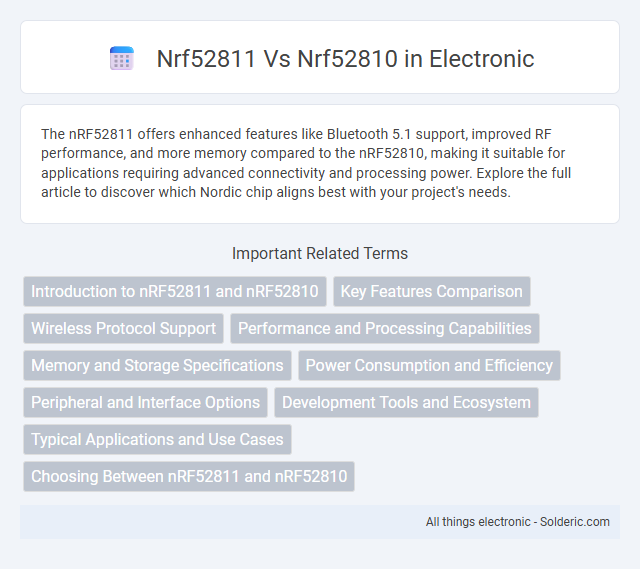The nRF52811 offers enhanced features like Bluetooth 5.1 support, improved RF performance, and more memory compared to the nRF52810, making it suitable for applications requiring advanced connectivity and processing power. Explore the full article to discover which Nordic chip aligns best with your project's needs.
Comparison Table
| Feature | nRF52811 | nRF52810 |
|---|---|---|
| Core | ARM Cortex-M4, 64 MHz | ARM Cortex-M4, 64 MHz |
| Flash Memory | 192 KB | 192 KB |
| RAM | 24 KB | 24 KB |
| Bluetooth | Bluetooth 5.0, Long Range, 2 Mbps | Bluetooth 5.0, 1 Mbps |
| Frequency Band | 2.4 GHz ISM Band | 2.4 GHz ISM Band |
| Radio Output Power | +4 dBm | 0 dBm |
| Package | QFN32, QFN48 | QFN32 |
| UART | Supported | Supported |
| SPI | Supported | Supported |
| I2C | Supported | Supported |
| Price | Moderate | Low |
Introduction to nRF52811 and nRF52810
The nRF52811 and nRF52810 are both Bluetooth Low Energy (BLE) SoCs from Nordic Semiconductor designed for wireless connectivity in IoT devices. The nRF52811 offers enhanced peripherals and supports Bluetooth 5.1, while the nRF52810 is optimized for lower power consumption with Bluetooth 5.0 support. Both chips provide ARM Cortex-M4 CPUs but differ mainly in features, memory, and radio capabilities tailored to specific application needs.
Key Features Comparison
The nRF52811 features Bluetooth 5.1 with Angle of Arrival (AoA) and Angle of Departure (AoD) support, 192KB Flash, and 24KB RAM, while the nRF52810 offers Bluetooth 5.0 with 192KB Flash and 24KB RAM but lacks AoA/AoD capabilities. The nRF52811 includes a QSPI interface for external memory expansion, enhancing storage potential, which the nRF52810 does not support. Both chips operate at 64MHz Cortex-M4 CPU cores but differ in advanced wireless protocols and peripheral options, making the nRF52811 more suitable for advanced location and connectivity applications.
Wireless Protocol Support
The nRF52811 supports Bluetooth 5.1, including Bluetooth Direction Finding and long-range capabilities, making it suitable for advanced wireless applications. In contrast, the nRF52810 supports Bluetooth 5.0 with basic functionality but lacks Direction Finding features. Choosing the nRF52811 enhances your device with improved wireless protocol support for more robust connectivity and range.
Performance and Processing Capabilities
The nRF52811 features a 64 MHz ARM Cortex-M4 CPU offering enhanced processing speed compared to the 64 MHz ARM Cortex-M4 in the nRF52810, with improved DSP and floating-point unit capabilities enabling efficient signal processing. The nRF52811 supports larger RAM sizes up to 24 KB versus the nRF52810's 24 KB, but with additional memory management improvements for performance optimization. Enhanced radio performance and multi-protocol capabilities further distinguish the nRF52811 in processing intensive applications within Bluetooth 5.1 environments.
Memory and Storage Specifications
The nRF52811 offers 192 KB of Flash memory and 24 KB of RAM, providing enhanced capacity for more complex applications compared to the nRF52810, which includes 192 KB of Flash but only 24 KB of RAM. Both chips support efficient storage and execution of firmware, but the nRF52811's expanded RAM improves performance for data-intensive tasks and real-time processing. Your choice between these two should consider the memory requirements of your specific IoT or Bluetooth LE project.
Power Consumption and Efficiency
The nRF52811 features improved power consumption efficiency compared to the nRF52810, consuming approximately 2.1 mA in active mode and 2.3 uA in system-off mode. It supports Bluetooth 5 features that enhance energy efficiency during data transmission, such as LE 2M PHY and extended advertising. The nRF52810, while still low-power, registers slightly higher active current consumption at around 3.0 mA, making the nRF52811 a better choice for ultra-low-power IoT applications.
Peripheral and Interface Options
The nRF52811 offers enhanced peripheral and interface options compared to the nRF52810, including support for NFC-A Tag, which the nRF52810 lacks. Both SoCs feature common interfaces such as SPI, UART, and I2C, but the nRF52811 integrates a UARTE peripheral for efficient data transfers. Additionally, the nRF52811 supports a higher number of PWM channels and provides a 32-bit timer, making it suitable for more complex applications requiring precise timing and extended interface functionality.
Development Tools and Ecosystem
The nRF52811 and nRF52810 both support Nordic Semiconductor's extensive development tools, including the nRF Connect SDK, Segger Embedded Studio, and ARM Keil, facilitating streamlined firmware development and debugging. The nRF52811 offers enhanced Bluetooth 5.1 features, which may require updated SDK versions for full utilization, while the nRF52810 remains compatible with broader legacy software support. Your choice between these SoCs should consider the ecosystem capabilities aligned with your project's Bluetooth requirements and development environment preferences.
Typical Applications and Use Cases
The nRF52811 is ideal for Bluetooth 5.1 direction finding applications, asset tracking, and smart home devices due to its advanced Bluetooth LE features and extended 1 Mbps/2 Mbps data rates. In contrast, the nRF52810 suits simpler Bluetooth Low Energy uses like basic wearables, fitness trackers, and simple IoT sensors, benefiting from its cost-effective design and essential BLE capabilities. Both chips support multi-protocol operations, but the nRF52811's enhanced processing power and memory make it better for complex or scalable IoT solutions.
Choosing Between nRF52811 and nRF52810
Choosing between the nRF52811 and nRF52810 depends on your specific application needs, especially in terms of Bluetooth capabilities and memory requirements. The nRF52811 supports Bluetooth 5.1 with Direction Finding and has 192 KB Flash and 24 KB RAM, offering enhanced wireless features and greater memory for complex applications compared to the nRF52810, which provides Bluetooth 5.0 with 192 KB Flash and 24 KB RAM but no Direction Finding. Your decision should prioritize whether advanced Bluetooth features and newer protocol support are critical to your project's success.
nrf52811 vs nrf52810 Infographic

 solderic.com
solderic.com